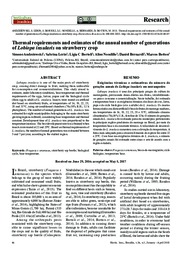Thermal requirements and estimates of the annual number of generations of Lobiopa insularis on strawberry crop.
Thermal requirements and estimates of the annual number of generations of Lobiopa insularis on strawberry crop.
Author(s): ANDZEIEWSKI, S.; LERIN, S.; BORTOLI, L. C.; NONDILLO, A.; BERNARDI, D.; BOTTON, M.
Summary: Lobiopa insularis is one of the main pests of strawberry crop, causing direct damage to fruit, making them unfeasible for consumption and commercialization. This study aimed to estimate, under laboratory conditions, base emperature and thermal requirements of the eggs, larvae, pupae and the biological cycle (from egg to adult) of L. insularis. Insects were reared on artificial diet based on strawberry fruits, at temperatures of 16, 19, 22, 25, 28 and 31°C, using air-conditioned chambers (70±10% R.H.; 12 h photophase). The number of annual generations of L. insularis was estimated for eight municipalities belonging to the main strawberry growing regions in Brazil, considering base temperature and thermal constant. Development time of L. insularis was proportional to the temperature increase. The best development rate was obtained when insects were reared at 22 and 25ºC. Based on thermal requirements of L. insularis, the number of annual generations was estimated between 5 and 7 per year, according to the studied region. Exigências térmicas e estimativas do número de gerações anuais de Lobiopa insularis em morangueiro Lobiopa insularis é uma das principais pragas da cultura do morangueiro, provocando danos diretos nos frutos, inviabilizando--os para o consumo e comercialização. Neste trabalho, foi estimada a temperatura base e as exigências térmicas das fases de ovo, larva, pupa e do ciclo biológico (ovo a adulto) de L. insularis. Os insetos foram criados em dieta artificial à base de frutos de morango maduros, nas temperaturas de 16, 19, 22, 25, 28 e 31°C, utilizando câmaras climatizadas (70±10% U.R.; fotofase de 12h). O número de gerações anuais de L. insularis foi estimado para oito municípios pertencentes às principais regiões produtoras de morango no Brasil, por meio da temperatura base e da constante térmica. A velocidade de desenvol-vimento de L. insularis aumentou com a elevação da temperatura. A faixa mais adequada para o desenvolvimento da espécie foi entre 22 e 25ºC. Com base nas exigências térmicas de L. insularis ,o número de gerações anuais foi estimado entre cinco e sete de acordo com a região estudada. Palavras-chave: Fragaria x ananassa, broca-do-morangueiro; ciclo biológico; temperatura base.
Publication year: 2018
Types of publication: Journal article
Unit: Embrapa Grape & Wine
Observation
Some of Embrapa's publications are published as ePub files. To read them, use or download one of the following free software options to your computer or mobile device. Android: Google Play Books; IOS: iBooks; Windows and Linux: Calibre.
Access other publications
Access the Agricultural Research Database (BDPA) to consult Embrapa's full library collection and records.
Visit Embrapa Bookstore to purchase books and other publications sold by Embrapa.

